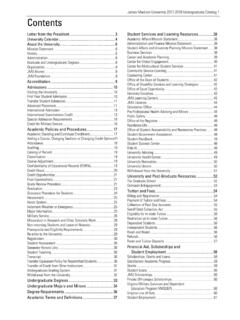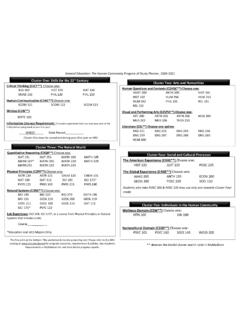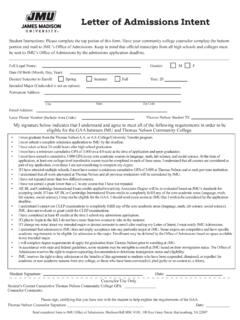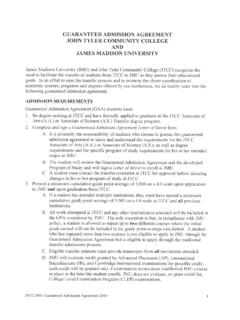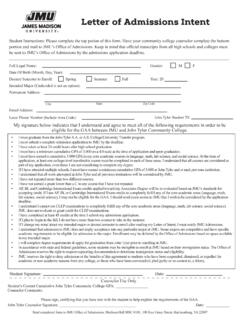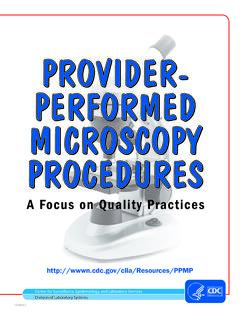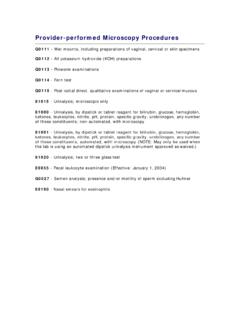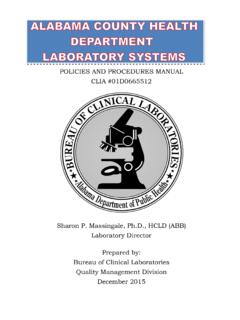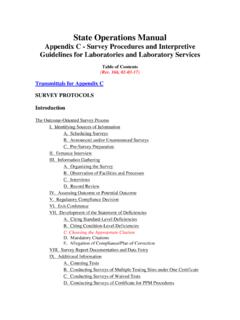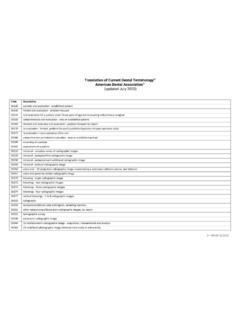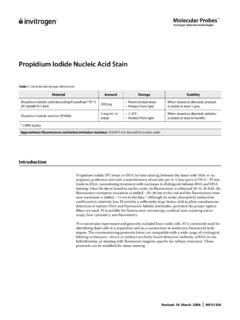Transcription of Basic Image Processing with FIJI/ImageJ
1 Basic Image Processing with FIJI/ImageJ . Kristopher Kubow, , James Madison University CONTENTS (CLICK TO JUMP TO SECTION). 1 No matter what you are doing, READ THIS FIRST .. 1. 2 Downloading FIJI/ImageJ .. 2. 3 Getting started .. 2. 4 Improving intensity visualization .. 3. 5 Working with multi-dimensional images opened as hyperstacks .. 4. 6 Shading correction .. 5. 7 Common modifications for preparing a figure .. 6. 8 Adding a scale bar to a figure .. 7. 9 Selected additional Resources .. 9. 1 NO MATTER WHAT YOU ARE DOING, READ THIS FIRST. IMPORTANT CONSIDERATIONS. Images are data. NEVER overwrite an original Image file. If you make adjustments to the Image , save it as a new file. Keep track of the manipulations you've made to each Image , in a simple text file that you place in the same folder as the Image . Because Image Processing changes an Image 's appearance, you must carefully consider the ethical implications of what you are doing. How do the changes you are making affect the interpretation and presentation of your data?
2 A full discussion of the ethical implications of Image Processing is beyond the scope of this guide. See this paper from Douglas Cromey at the University of Arizona for a brief overview. When in doubt, talk with your advisor and/or the light microscopy facility director. Except for ethically applied simple linear histogram (intensity) adjustments, reducing bit depth, and cropping, ALL Image Processing procedures MUST be disclosed in your Methods section and/or figure legend. CONVENTIONS USED IN THIS DOCUMENT. For a quick introduction to the layout of the ImageJ program, see here. Navigation through menus and sub-menus is notated using >'. For example, Image > Type . tells you to go to access the Image menu and then the Type sub-menu. True-color images are images of specimens with color ( histological stains). Fluorescence images are NOT color images; they are monochrome (black and white) and the color is added by the computer. (In rare cases, you may have taken a fluorescence Image with a color camera; in this case, you should convert the Image to monochrome.)
3 See Section 3.). 1. 2 DOWNLOADING FIJI/ImageJ . FIJI is a pre-packaged version of ImageJ that is pre-configured with numerous useful plugins. Most importantly, it allows you to open Image files generated by nearly any microscope/camera software. The Basic version of ImageJ cannot do this without loading additional plugins. Although I usually refer to the program as ImageJ in the following instructions, I am assuming you are actually using the FIJI version of ImageJ and NOT the Basic version. To install FIJI, download the version appropriate for your operating system here. Save the installation file anywhere convenient (except in the Program Files folder if you are running Windows). Uncompress the file and the application is ready to use; there is no installation procedure. To start the program, double-click the file. 3 GETTING STARTED. OPENING AN Image FILE. Open an Image file by dragging and dropping it onto the ImageJ main control panel. Most simple images (.jpg and .tif files) will open immediately.
4 More complex files (.jp2, .nd2, .zvi files) will display a large panel called Bio-Formats Import Options. Select hyperstack in the first drop-down and be sure that all boxes are unchecked. o If you have a true-color Image ( histology), once the Image opens, select Image >. Type > RGB Color. Close the old Image and work with the new one. o See Section 5 for how to work with multi-dimensional images ( with >1 channel, z- slice, time-point, etc.). If your Image is a color Image (RGB), but there is no important color information in the Image ( fluorescence; non-stained DIC), then it's best to convert the file to monochrome (black and white): go to Image > Type > 8-bit. The color information is unnecessary. Does the Image look completely dark or very dim? You need to adjust the intensities. See Section 4. NAVIGATING YOUR Image . Zooming: Press + to zoom-in; press - to zoom-out. Panning (moving the Image around): hold-down the spacebar while clicking and dragging (or use the hand tool on the toolbar).
5 2. 4 IMPROVING INTENSITY VISUALIZATION. This is most critical with fluorescence images. If you are adjusting a true-color Image ( histology), be sure that it is in RGB Color (go to Image > Type > RGB Color). LINEAR HISTOGRAM ADJUSTMENTS. 1. Go to Image > Adjust > Brightness/Contrast (or press SHIFT-C). You'll see a panel with a histogram of all the intensities in this Image . 2. Dragging the Maximum slider to the left will increase the brightness of the Image . Do not increase the brightness so much that you saturate (wash-out) features in your Image . 3. Dragging the Minimum slide to the right will increase the contrast of the Image . Do not increase the contrast so much that dim features in the background disappear. 4. All of your changes are temporary unless you click Apply. Note that there is NO undo. Remember to save this Image as a new file and DO NOT overwrite the original file. GAMMA ADJUSTMENT. Sometimes an Image contains a wide range of intensities and it is difficult to find a display range that shows the dimmest objects while not saturating the brightest.
6 Adjusting the gamma setting may help. 1. First, adjust the brightness and contrast (see Section , above). 2. Next, try adjusting the gamma setting. This setting basically changes how intensities are scaled between the two limits (min and max) that you set in the B&C panel. Gamma = is normal. Values < accentuate differences between low intensities while values > accentuate differences between high intensities. a. Go to Process > Math > Gamma . b. Be sure that Preview is checked c. Try adjusting the gamma value. 3. Hit Apply on the B&C panel and save this Image . Note that there is NO undo. Remember to save this Image as a new file and DO NOT overwrite the original file. SINGLE-CHANNEL FLUORESCENCE IMAGES. In general, you should always display single-channel fluorescence images in black and white. If there is a large range of intensities in the Image and it is difficult to find a display range that allows visualization of the dimmest objects while not saturating the brightest, you can consider applying a look-up-table (LUT).
7 (See the above sub-section for an alternative strategy.) In addition, if you really need to color your single-channel Image , you can also do this with a LUT. To see a listing of the available LUTs, go to Image > Color > Display LUTs. The multi-color LUTs are to help you visualize a large range of intensities. The single-color LUTs are to color a monochrome Image . To apply a LUT to your black and white Image (or to change you color Image to monochrome): 1. Click on the LUT button on the main ImageJ toolbar 2. Select a LUT (choose Grays for black and white). 3. 5 WORKING WITH MULTI-DIMENSIONAL IMAGES OPENED AS HYPERSTACKS. Multi-dimensional images will be displayed in a window with scroll bars at the bottom that allow you to scroll through each of the available dimensions (c = channel, z = z-slice, t = time-point). How to extract a single Image from a multi-dimensional series: 1. Be sure the Image is displayed exactly as you desire. 2. Edit > Copy 3. File > New > Internal Clipboard 4.
8 This procedure only works for single-channel images. If you have a multi-channel Image , you must be in Color or Grayscale mode or convert it to RGB first (see Section , below). IMAGES WITH MULTIPLE CHANNELS. Open the Channels Tool: press SHIFT-Z or go to Image > Color > Channels Tool . How to control how the channels are displayed using the pull-down menu: Composite allows you to see all channels at the same time (overlayed). Use the check boxes to determine which channels are displayed. Color displays only one channel at a time. Use the check boxes to switch between channels (you can also use the scroll bar in the Image window). Grayscale is the same as Color except it shows the channels in grayscale. How to control the intensity and/or color of each channel: 1. Switch to Color mode using the pull-down menu. 2. Select the channel you want to change. 3. Change the brightness and contrast as described in Section 4. 4. Change the color by clicking the More >> button and selecting the desired color from the drop-down menu.
9 How to convert a Composite (overlay) Image to RGB for importing into PowerPoint, Photoshop, etc.: Click the More >> button and select Convert to RGB . It is difficult to undo this process, so be sure to save your new Image as a new document; do not overwrite the original. IMAGES WITH MULTIPLE Z-SLICES ( A Z-STACK). There are a large number of z-stack manipulations that can be performed with ImageJ. The most common operation with z-stacks is to generate a z-projection: 1. Image > Stacks > Z-project . 2. Select the beginning and ending slices to be included in the projection (default is to use the entire stack). 3. Select the projection type. Maximum is commonly used for fluorescence images. 4. 6 SHADING CORRECTION. This kind of correction is especially important for DIC but is also useful for any time when illumination is uneven or there is dirt in the optics that you want to remove. In the Flat-Field Correction process, a background Image ( nothing in the field-of-view) is divided from your Image to cancel-out any variation in background intensity.
10 What if you didn't take any background images? Use the Pseudo-Flat- Field Correction it works almost as well. FLAT-FIELD CORRECTION. 1. Take your Image . 2. Take your background Image : without changing any settings, move to a blank area of the slide and take an Image . If you're having trouble finding a completely empty area, try de-focusing to blur-out the objects. Alternatively, you can carefully remove your slide and put in an empty slide to get a background Image . 3. Open both images in ImageJ. 4. Select the background Image and hit Ctrl-A to select the entire Image . Press m to measure the mean intensity of the Image . 5. Go to Process > Calculator plus. 6. Set the following parameters, then hit OK: a. i1 = the Image b. i2 = the background Image c. Operation = Divide ( k1*(i1/i2) + k2 ). d. k1 = the mean intensity you just measured e. k2 = 0. 7. A new window appears with you corrected Image . PSEUDO-FLAT-FIELD CORRECTION. If you didn't take a background Image . 1. Open your Image that you want to correct.
